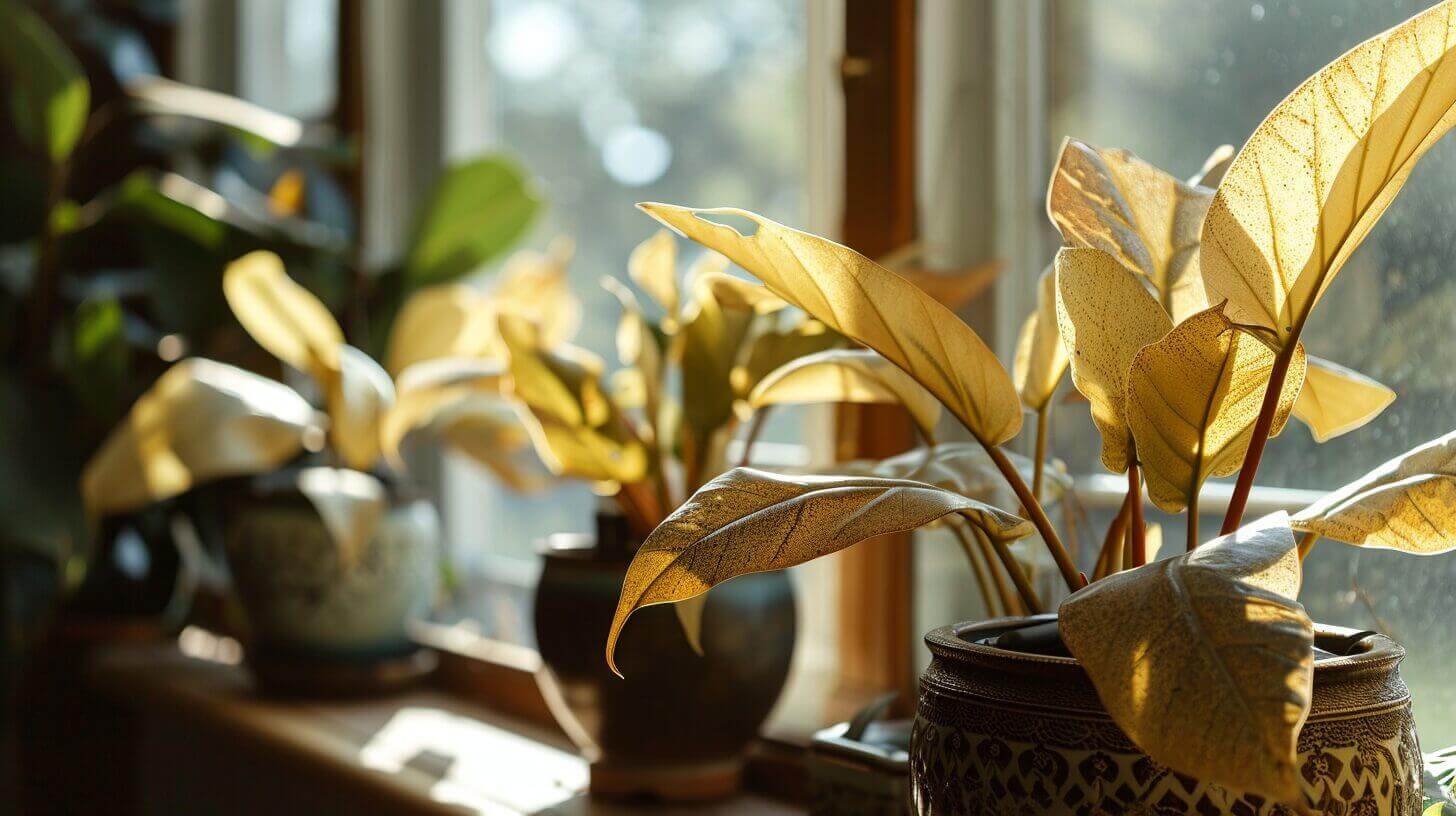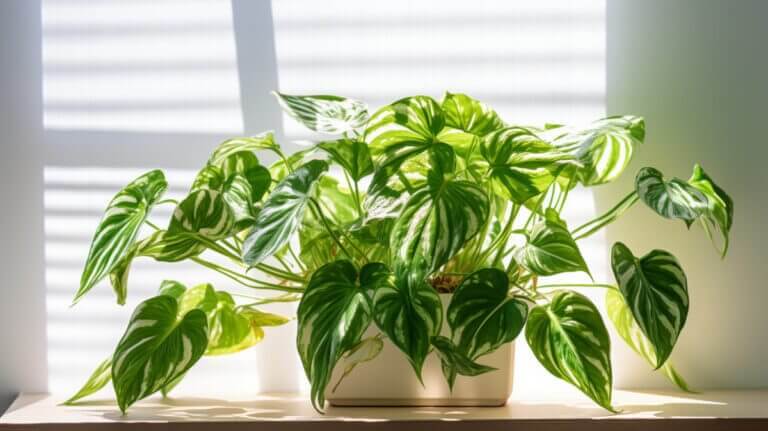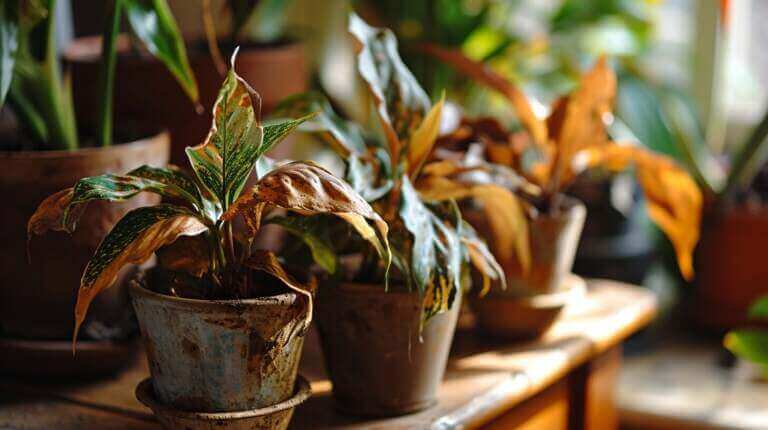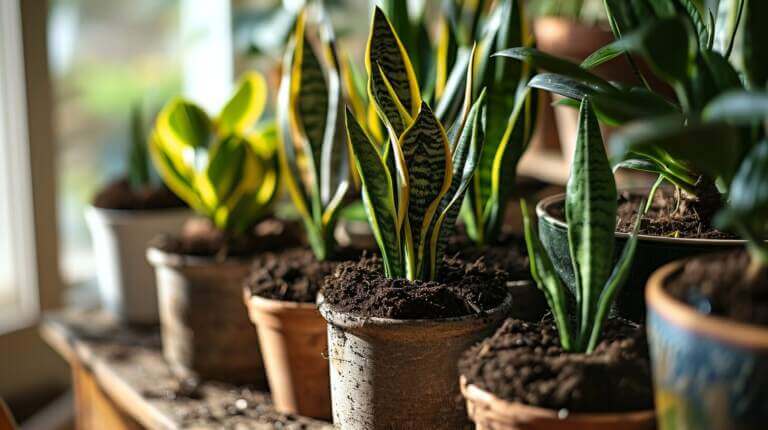If you’ve noticed that your arrowhead indoor plant develop yellow leaves, it’s important to understand the reasons behind this and take appropriate measures to address it. Yellow leaves on arrowhead plants can be indicative of various issues, including improper soil moisture, low humidity, improper lighting, temperature fluctuations, nutrient deficiencies, and pest infestations. By identifying the cause and implementing the correct solutions, you can restore your plant’s health and prevent further yellowing.
Key Takeaways:
- Improper soil moisture, such as overwatering or underwatering, is the most common cause of yellowing leaves in arrowhead plants.
- Low humidity, improper lighting, temperature fluctuations, nutrient deficiencies, and pest infestations can also contribute to yellowing leaves.
- To address the issue, adjust the watering schedule, provide proper humidity levels, ensure adequate lighting, maintain a consistent temperature, fertilize the plant, and address any pest problems.
- Removing yellow leaves and promoting overall plant health through proper care practices can help prevent further yellowing.
- By understanding the causes and implementing effective solutions, you can restore your arrowhead plant’s health and keep it thriving.
Improper Soil Moisture as a Common Cause
Improper soil moisture levels, whether it’s overwatering or underwatering, can be a major factor contributing to the yellowing of arrowhead plant leaves. These plants are native to tropical rainforests, so it’s important to replicate their natural habitat conditions as closely as possible. Let’s dive into the details of how improper soil moisture affects the health of arrowhead plants and what you can do to prevent yellowing leaves.
Overwatering your arrowhead plant can lead to root rot, which inhibits the plant’s ability to absorb nutrients and water properly. It’s crucial to strike a balance and avoid drowning the roots. On the other hand, underwatering can cause dehydration and stress, resulting in yellowing leaves. The key is to provide adequate moisture without overdoing it.
To maintain the perfect soil moisture level for your arrowhead plant, you can follow a few simple steps. First, ensure that the soil is well-draining, as waterlogged soil can suffocate the roots. Additionally, water your plant thoroughly, allowing excess water to drain out of the pot. Then, wait until the top inch of soil feels dry before watering again. This ensures that the roots have access to sufficient moisture without being constantly saturated.
| Signs of Overwatering | Signs of Underwatering |
|---|---|
|
|
Preventing Improper Soil Moisture
Proper watering is crucial for maintaining the health of your arrowhead plant. Avoid overwatering by allowing the soil to dry out between waterings and ensuring good drainage. You can test the moisture level by inserting your finger into the soil; if it feels moist, hold off on watering. If you suspect underwatering, water your plant thoroughly until water starts to drain from the bottom of the pot, then allow the soil to dry out before the next watering.
“Finding the right balance of moisture is key when it comes to preventing yellowing leaves in arrowhead plants. Keeping an eye on their soil moisture and responding accordingly can help maintain their vibrant green foliage.”
Remember, improper soil moisture is just one of the many factors that can cause yellowing leaves in arrowhead plants. By addressing this issue and considering other factors such as humidity, lighting, temperature, nutrients, and pests, you can help restore your plant’s health and prevent further yellowing. Pay close attention to your plant’s needs and provide the necessary care to keep it thriving.
Other Factors Contributing to Yellowing Leaves
Apart from soil moisture issues, several other factors can lead to the yellowing of your arrowhead plant’s leaves. These factors include low humidity, improper lighting, temperature fluctuations, nutrient deficiencies, and pest infestations. Addressing these factors is crucial for restoring the plant’s health and preventing further yellowing.
Low Humidity
| Signs of Low Humidity | Solutions |
|---|---|
| Wilting leaves | Place a tray of water near the plant to increase humidity |
| Brown leaf tips | Mist the leaves with water regularly |
Improper Lighting
Insufficient or excessive light can contribute to yellowing leaves. Here are some tips to ensure your arrowhead plant gets the right amount of light:
- Place the plant near a bright but indirect light source
- Avoid exposing the plant to direct sunlight, as it can scorch the leaves
Temperature Fluctuations
Drastic temperature changes can stress the plant and cause leaf yellowing. To maintain a consistent temperature:
- Avoid placing the plant near drafty windows or doors
- Keep the plant away from heating or cooling vents
Nutrient Deficiencies
Lack of essential nutrients can weaken the plant and lead to yellowing leaves. Fertilize your arrowhead plant regularly to provide it with the necessary nutrients. A balanced fertilizer with equal amounts of nitrogen, phosphorus, and potassium is ideal for arrowhead plants.
Pest Infestations
Common pests like spider mites, aphids, and mealybugs can damage the leaves, causing them to turn yellow. Use appropriate pesticides or insecticidal soaps to get rid of these pests. Regularly inspect your plant for signs of infestation.
By addressing these factors and implementing the proper solutions, you can restore your arrowhead plant’s health and prevent further yellowing of its leaves. Remember to remove any yellow leaves promptly and maintain a consistent care routine to promote overall plant health.
Effective Solutions for Restoring Plant Health
To restore your arrowhead plant’s health and prevent further yellowing, there are several effective solutions you can implement. Adjusting the watering schedule is crucial, as improper soil moisture is often the main culprit behind yellow leaves.
Overwatering can lead to root rot, while underwatering can cause dehydration and stress. Aim to keep the soil slightly moist but not waterlogged, allowing it to dry out slightly between waterings. This will help promote healthy root growth and prevent water-related issues.
Proper humidity levels are also essential for the well-being of your arrowhead plant. These plants thrive in high humidity environments, so consider using a humidifier or placing a tray filled with water near the plant to increase moisture levels.
Additionally, be mindful of the plant’s lighting conditions. Inadequate light or excessive exposure to direct sunlight can cause yellowing of leaves. Find a balance by placing your arrowhead plant in bright, indirect light for optimal growth.
Maintaining a consistent temperature is equally important. Arrowhead plants prefer temperatures between 60-75°F (15-24°C). Sudden temperature fluctuations can stress the plant and lead to yellowing leaves. Avoid placing the plant near drafty windows or vents, and try to maintain a stable temperature in its vicinity.
Fertilizing the plant regularly will provide it with the necessary nutrients it needs to stay healthy. Use a balanced, water-soluble fertilizer and follow the manufacturer’s instructions for application. Overfertilizing can cause nutrient burn, so it’s important not to exceed the recommended dosage.
Lastly, address any pest problems promptly. Common pests that can attack arrowhead plants include spider mites, mealybugs, and aphids. Use organic pest control methods or insecticidal soap to eradicate the pests and prevent further damage.
| Effective Solutions for Restoring Plant Health | |
|---|---|
| Adjusting watering schedule | Ensure the soil is moist but not waterlogged, allowing it to dry out between waterings. |
| Providing proper humidity levels | Use a humidifier or place a tray filled with water near the plant to increase humidity. |
| Ensuring adequate lighting | Place the plant in bright, indirect light to promote healthy growth. |
| Maintaining consistent temperature | Avoid temperature fluctuations and keep the plant in the preferred temperature range of 60-75°F (15-24°C). |
| Fertilizing the plant | Use a balanced, water-soluble fertilizer according to the manufacturer’s instructions. |
| Addressing pest problems | Identify and eliminate common pests using organic pest control methods or insecticidal soap. |
Proper Care and Maintenance Tips
In addition to addressing the causes of yellowing leaves, it’s crucial to follow proper care and maintenance practices to ensure the well-being of your arrowhead plant. By providing the right conditions and implementing these tips, you can promote overall plant health and prevent further yellowing.
1. Adjust Watering Schedule:
Proper watering is essential for the health of your arrowhead plant. Overwatering can lead to root rot, while underwatering can cause dehydration and stress. To avoid these issues, water your plant when the top inch of soil feels dry. Ensure that the pot has drainage holes to prevent water from pooling at the bottom. Remember, it’s better to underwater than to overwater, as arrowhead plants prefer slightly drier conditions.
2. Provide Proper Humidity Levels:
Arrowhead plants thrive in high humidity environments. To maintain optimal humidity, you can mist the leaves regularly or place the plant on a tray filled with water and pebbles. This creates a humid microclimate around the plant. Alternatively, you can use a humidifier to keep the air moist. Avoid placing the plant near drafts or heating vents, as it can lead to dry air and cause leaf yellowing.
3. Ensure Adequate Lighting:
Proper lighting is crucial for the growth and foliage color of your arrowhead plant. Place it in bright, indirect light, away from direct sunlight. If the leaves start to turn yellow, it could indicate insufficient light. Move the plant closer to a window or provide supplemental artificial light to improve its overall health.
4. Maintain Consistent Temperature:
Arrowhead plants prefer temperatures between 60-75°F (15-24°C). Avoid exposing the plant to cold drafts or extreme temperature fluctuations, as it can stress the plant and lead to yellowing leaves. Keep it in a stable environment, away from cold drafts or heating sources.
5. Fertilize the Plant:
Regular fertilization can provide essential nutrients for your arrowhead plant. Use a balanced, water-soluble fertilizer once a month during the growing season (spring and summer). Make sure to follow the instructions on the fertilizer packaging for the correct dosage and application method. Overfertilizing can damage the plant, so it’s important to use fertilizer in moderation.
6. Address Pest Problems:
Pests like spider mites, aphids, and mealybugs can damage your arrowhead plant and contribute to yellowing leaves. Regularly inspect your plant for signs of pests, such as webs, sticky residue, or tiny insects. If you notice any infestation, carefully remove the pests using a mild soap and water solution or an organic insecticidal soap. Ensure that the entire plant, including the undersides of leaves, is treated. Repeat the treatment as necessary to eliminate the pests and prevent further damage.
By following these care and maintenance tips, you can remove yellow leaves, promote overall plant health, and prevent future yellowing. Remember to observe your arrowhead plant closely and adjust care practices based on its specific needs. With proper attention and care, your arrowhead plant will thrive and display vibrant, healthy foliage.
FAQ
Why are the leaves on my syngonium leaves turning yellow?
The most common cause of yellowing leaves in arrowhead plants is improper soil moisture, such as overwatering or underwatering. Other factors such as low humidity, improper lighting, temperature fluctuations, nutrient deficiencies, and pest infestations can also contribute to yellowing leaves.
How does overwatering affect arrowhead plants?
Overwatering can lead to root rot in arrowhead plants, which can cause the leaves to turn yellow. It is important to adjust the watering schedule and make sure the plant is not sitting in waterlogged soil.
What happens if an arrowhead plant is underwatered?
Underwatering can cause dehydration and stress in arrowhead plants, leading to yellowing leaves. It is essential to ensure that the plant is receiving enough water and to adjust the watering frequency accordingly.
What other factors can cause of yellowing leaves in arrowhead plants?
Apart from improper soil moisture, low humidity, improper lighting conditions, temperature fluctuations, nutrient deficiencies, and pest infestations can also cause the leaves of arrowhead plants to turn yellow.
How can I restore the health of my arrowhead plant?
To restore the health of your arrowhead plant, you can adjust the watering schedule, provide proper humidity levels, ensure adequate lighting, maintain a consistent temperature, fertilize the plant with appropriate nutrients, and address any pest problems that may be present.
Should you remove yellow leaves on your arrowhead plant?
Yes, it is important to remove yellow leaves from your arrowhead plant. This not only improves the appearance of the plant but also helps prevent further yellowing and promotes overall plant health.
How can I prevent leaves on arrowhead plant turning yellow?
To prevent yellowing leaves in your arrowhead plant, it is crucial to provide proper care and maintenance. This includes adjusting the watering schedule, maintaining proper humidity levels, ensuring adequate lighting, maintaining consistent temperatures, fertilizing the plant, and promptly addressing any pest problems that may arise.







